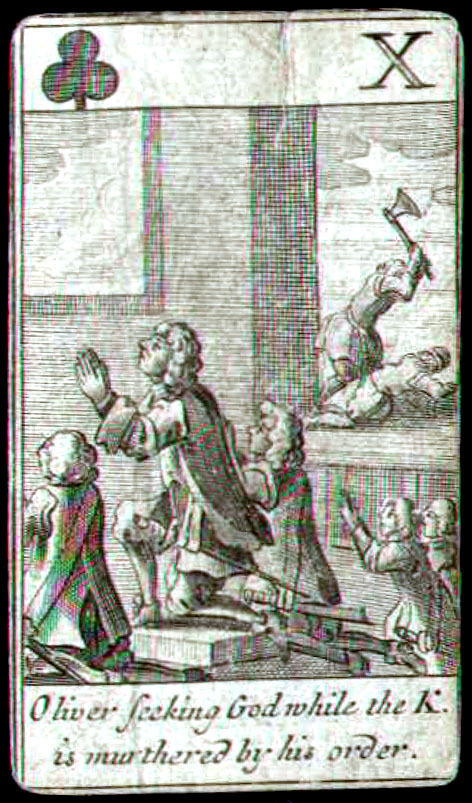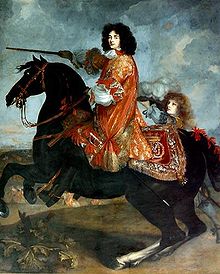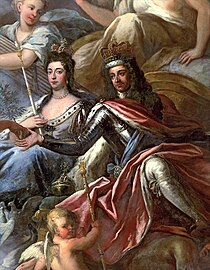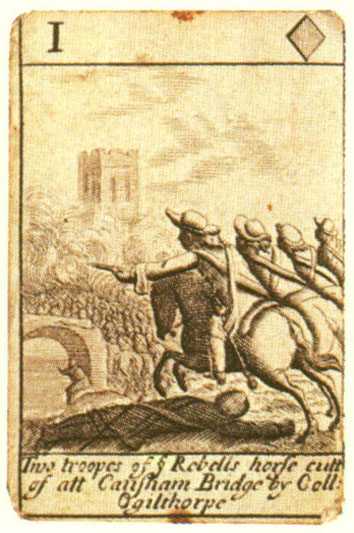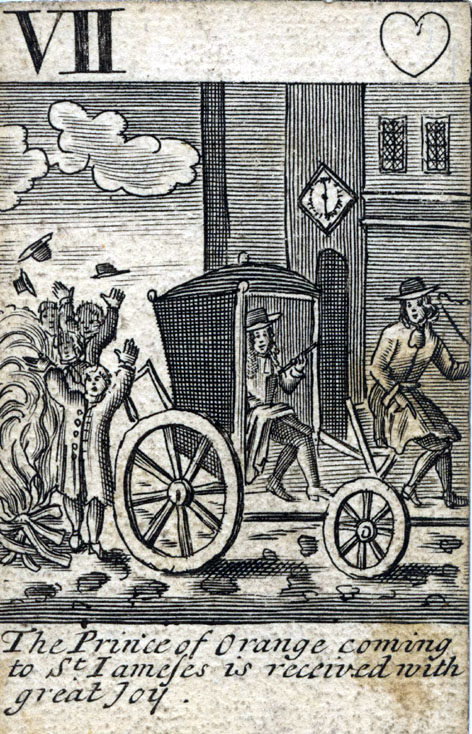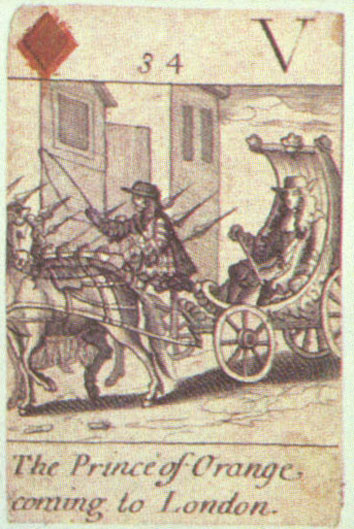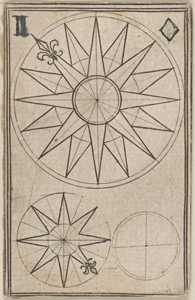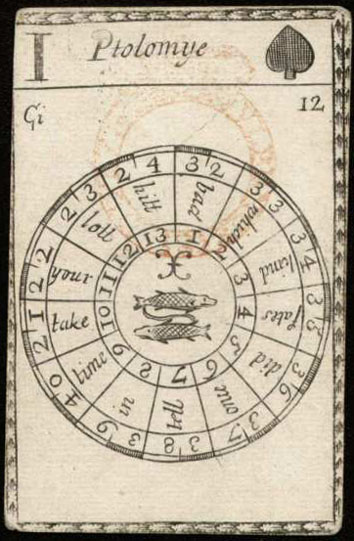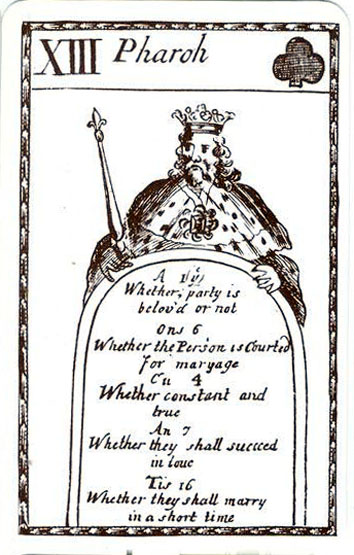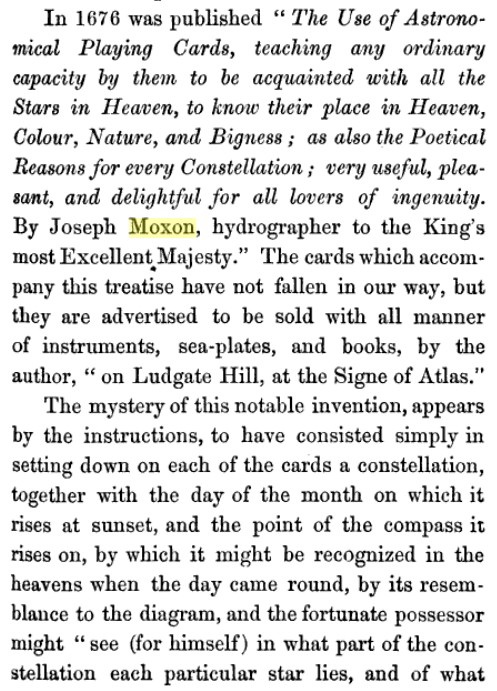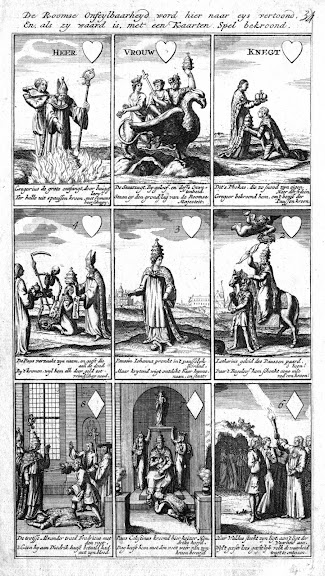... luckily I opened a book, and saw Lenthall Pack No. XVIII, just the deck in question.
... that article appeared in IPCS vol. VII, No 1 August 1978 by Virginia and Harold Wayland
"Fortune Telling Cards, pleasantly unfolding the good and bad Luck attending Life.". With Direction to Use the Cards. Lenthall Broadside 1724."
The authors see a first indication of the existence of Lenthall Fortune telling cards in an advertisement in the British Mercury of 12-15 October, 1711.
The Waylands have located 13 full or partial packs in different collections - much of the decks have a "Use" card and knave of Clubs with "Hewson the regicide" ...
http://en.wikipedia.org/wiki/John_Hewson_%28regicide%29
... who in January 1649 signed the death warrant for Charles I (and died himself in 1662). The Waylands tell, that this had led to many wrong ideas about the person of Lenthall and the age of this deck ... for which they partly make responsible Rev. Ed. S Taylor and his History of Playing Cards, page 209, which should be this one:
http://books.google.com/books?id=qKxAAAAAcAAJ ... page 209
The "Use card" are two cards and they are printed in the article. Newspaper advertisements for the deck are found in a period of 50 years later (after 1711) mostly during the autumn season, so it is suspected, that it sold best in the Christmas / New Years's time.
According the Waylands there was another, earlier, publisher of the deck: Dorman Newman, a book-seller in London 1665 - 1693. The deck was first published (as known by an advertisement) 1690 - as far this is known. Dorman Newman went bankrupt in 1694, and as next publisher of the same deck appeared a Hugh Newman (a relative) in 1699 and 1705 in advertisements. The designer stays unknown ... so the Waylands in 1978.
Moxon is not mentioned by the Waylands, though they mention earlier interpretations with earlier datings.
How to use the cards: Take a questions of the Kings (4 kings, each has 5 questions and each question has letters and numbers).
Le's do ...
Whether they shall succeed in love ... That's an "An 7"
Each letter combination leads to a wheel, found at the 20 odd-numbered cards (1-3-5-7-9), which use the 12 zodiac-signs, the 7 planets and the 20th is an Omega.
Now the cards are shuffled and if you get (for instance) a "Queen", then it's "12" and you go to the already selected wheel card, which belongs to your question. There you look at the inner ring for "12" and not the results at the two outer rings. In this case "tell" and "38". Now you look at the Queen and Jack cards, if you find "tell 38"
Cupido, that looks good. The "tell 38" connects to "Vates etc." and "44" ... and I shall look at all the "even numbered" cards. ...

... Well, I don't find it, as the Museum hasn't a complete deck. So I take just another card, and number 12 was my number ...
... "They are found, safe and sound" ... that's not so bad ... .-)
***************
In Taylor's book (which got the critique by the Waylands) I found two other notes about Moxon:
Page 207:
It seems, that we here find the reason for Sascha's error about these cards (it seems plausible, that he got this error from somebody else).
Sascha wrote to the Newman/Lenthall deck:
"James Moxon" (UK)
deck "Astrology", 1676
reprinted by John Lenthall in 1717 (1714?) as "Fortune Telling Cards No.XVIII"
reprinted by Harry Margary (Kent) in 2004 (dimension 62x98 mm.)
From Taylor's description the deck doesn't fit with the Lenthall deck. This deck is advertised 1676 and if one doesn't identify it as lot book, one easily might think, that it is an astrology deck. .
But who knows ... possibly since 1978 somebody has explored something different.
Page 214:
This seems to be a real 4th Moxon deck, the description doesn't sound astronomical, astrological and isn't for sure not geographical.
Earlier I wrote:
A further report ..
http://www.pachs.net/blogs/comments/mak ... ing_cards/
... shows, that the author isn't aware, that there is more than one Moxon, but it also has the worthwhile information:
Moxon considered playing cards to be a useful way to teach astronomy and geography. He was not the only person to print playing cards—the geographer John Adair and the mathematician Thomas Tuttell both made playing cards. Moxon produced three different sets of playing cards:
* Astronomical Playing Cards, which cost 6d
* Astronomical Cards, which cost 1s for plain ones up to 5s for a colored and gilded set
* Geographical Playing Cards, which cost 1s for plain ones up to 5s for a colored and gilded set
Now I would say:
* Astronomical Playing Cards, which cost 6d
this from 1476 ?
* Astronomical Cards, which cost 1s for plain ones up to 5s for a colored and gilded set
this from 1492 ?
Or are both the same?
The 1476 production is announced with the same title
* Geographical Playing Cards, which cost 1s for plain ones up to 5s for a colored and gilded set
This we have in the Museum
* The Carving Board playing cards ... and this might be the fourth Moxon deck ... or the 3rd?







